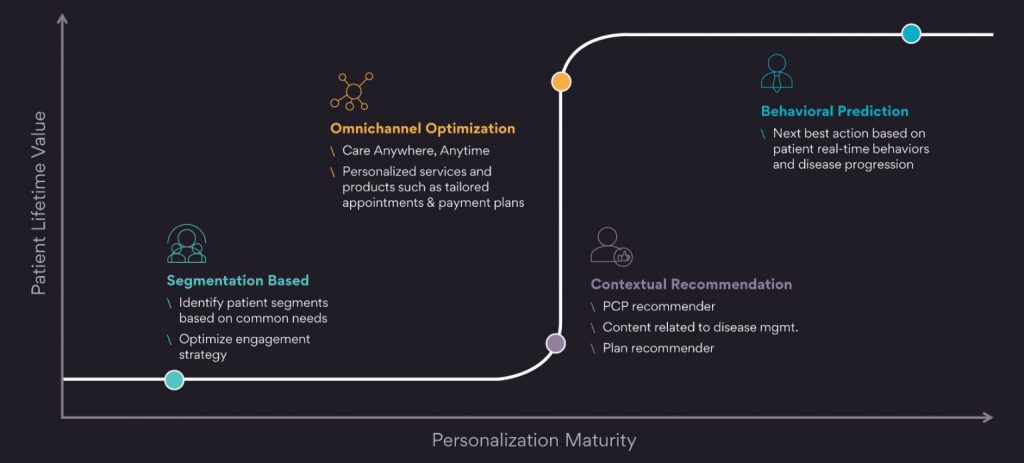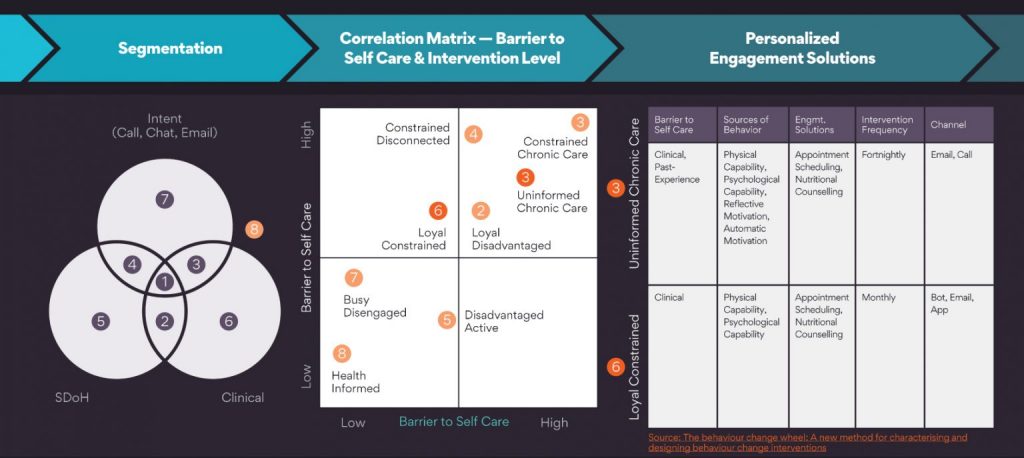Industries such as retail, e-commerce, media and entertainment offer a deep level of personalization to their consumers. The benefits that these industries have derived from such efforts are galvanizing the healthcare organizations (HCOs) to invest in personalization initiatives. Some are already ahead of the curve and reaping the returns of such initiatives, while others have embarked on this transformational path.
Before we deep dive into our patient personalization solution, let’s explore why do HCOs need it, the foundational framework behind the solution, AWS (Amazon Web Services) based architecture and a use case which shows it at work. We will conclude by elaborating the various elements of the solution that will be helpful to different players in the healthcare ecosystem and the key differentiators.
Personalization: Need of the hour
As enumerated by the numbers below, the positive impact of personalization on revenues and costs make it imperative for HCOs to invest in it:
- 57% influence on CMS Rating: By 2023, measures related to patient experience will have major contribution to overall star rating
- $444 Additional Revenue: Hospitals with better patient experience earn more revenue than those with lower ratings on average per patient day
- 25-35% Increased Profits: Increase in profits by increasing retention rates by 5%
- $6K-$20K Revenue Loss: Revenue loss when single user abandons online health insurance shopping cart
- 5x Patient Acquisition Cost: Patient acquisition efforts cost more than efforts to secure existing patients
Personalization: PoV
The healthcare space has undergone a significant transformation after the COVID-19 pandemic, especially the care delivery channel. All the HCOs are focusing more on patient convenience, leading to care services shifting outside the traditional delivery centers to patient-preferred channels. It’s about omnichannel care—anywhere, anytime. Self-care is also going to play a significant role in this trend. If HCOs want to leverage this trend, then they need to get to know their patients or members well. This is where personalization becomes an enabler. This entire process of mass-based service delivery to personalized service delivery involves incremental innovation. It can be laid out in the following 4 milestones. The reward for achieving each is a higher patient or member lifetime value than the previous one.

Challenges: Healthcare is not retail
Before we take a deep dive into the framework and the workings of the solution, a word of caution: this is healthcare that we are dealing with and not the gold standard of personalization, i.e., retail. Though not insurmountable, the very state of the industry, rules of the game and the focus point, i.e., patient, his/her behavior, and outlook towards his/her well-being, all add up to the list of barriers one must first cross to attain the levels of personalization enumerated in the prior section.
Besides these, there are other factors such as capturing, cleaning, storage, security, stewardship of data, interoperability or the lack of it, sheer volume, and the velocity of data. They make attainment of subsequent stages of personalization an uphill task. We believe it’s an S-curve to transition from a lower level of personalization maturity to a higher one. With the right data and sources, a proven framework, and a robust platform, HCOs can embark on the journey of personalization and reach all the cherished milestones.
Framework and solution:

The above figure gives an overview of the approach used by the solution. Insights from factors-intent, clinical conditions and social determinants of health-affecting human behavior and perceptions can help in providing optimal level of interventions to enable self-care. These interventions, in the form of personalized, convenient, and timely “nudges” can benefit patient or member (higher-quality care, lower out-of-pocket costs, improved experience) and the healthcare provider (lower unnecessary emergency department [ED] utilization, fewer unnecessary procedures, and increased member satisfaction).
The personalized patient engagement solution, has used a classification algorithm to create eight different patient segments having similar care needs. The segmentation is done based on diverse patient datasets related to intent (derived from various conversation and interaction channels), clinical conditions, and social determinants of health. Each patient segment has specific behaviors that lead to corresponding barriers to self-care. For example, a person belonging to segment 8 (Healthy Informed) is aware of a healthy lifestyle, does not have a serious clinical condition and has an extremely low vulnerability to SDoH factors. Hence, this person will have the lowest level of barrier to self-care as compared to one from segment 6 (Loyal Constrained) having serious clinical conditions such as multiple chronic diseases or frequent hospital visits etc.
Based on the level of barrier to self-care, optimum intervention levels are identified based on the COM-B model for behavior change. The COM-B model for behavior change cites capability (C), opportunity (O), and motivation (M) as three key factors capable of changing behavior (B). Capability refers to an individual’s psychological and physical ability to participate in an activity. Opportunity refers to external factors that make a behavior possible. Lastly, motivation refers to the conscious and unconscious cognitive processes that direct and inspire behavior. This model recognizes that behavior is influenced by many factors and that behavior changes are induced by modifying at least one of these components.
Our personalization solution provides the optimum type and frequency of “nudges” in the form of appropriate interventions (as per care guidelines) through preferred channels of interventions to enable patients to make better and timely decisions about their health.
References:
- https://www.mckinsey.com/industries/healthcare-systems-and-services/our-insights/new-stars-ratings-for-medicare-advantage-prioritize-customer-experiences
- https://www2.deloitte.com/content/dam/Deloitte/us/Documents/life-sciences-health-care/us-dchs-the-value-of-patient-experience.pdf
- https://hbswk.hbs.edu/archive/the-economics-of-e-loyalty
- https://www.outboundengine.com/blog/customer-retention-marketing-vs-customer-acquisition-marketing/
Contact our experts for a 1:1 demo on how your organization can leverage patient personalization to collect and unify disparate patient data, gather intelligent, actionable, and trusted insights to deliver efficient and personalized care delivery. Read more about AWS Healthcare and Life Sciences Competency.






